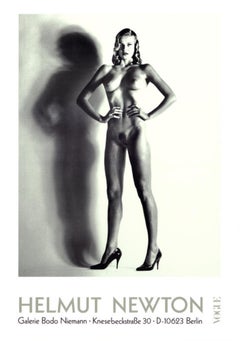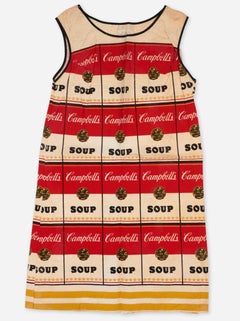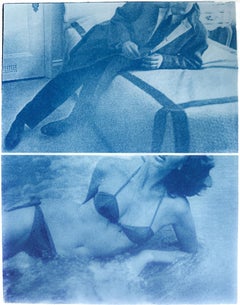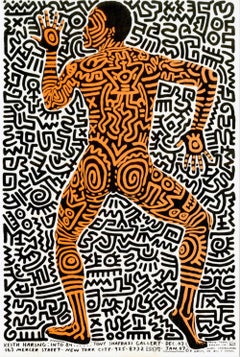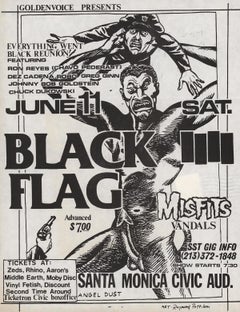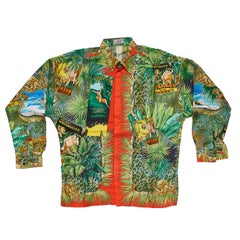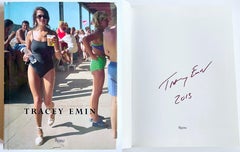Swimsuit More Art
to
1
2
Overall Width
to
Overall Height
to
2
1
1
1
2
1
3
1,854
317
216
190
137
118
99
79
69
67
59
54
54
52
49
47
47
46
44
44
2
2
1
1
1
1
2
1
Art Subject: Swimsuit
Big Nude By Helmut Newton
Located in Dubai, Dubai
Big Nude
By Helmut Newton
1992
Medium: Offset Lithograph
Paper Size: 33 x 23.25 inches ( 84 x 59 cm )
Image Size: 25.5 x 19.75 inches ( 65 x 50 cm )
Edition Size: Unknown
Category
1990s Contemporary Nude Prints
Materials
Lithograph, Offset
Andy Warhol The Souper Dress (Andy Warhol Campbells)
By Andy Warhol
Located in NEW YORK, NY
Andy Warhol The Souper Dress c. 1965-1967:
Inspired by Andy Warhol’s Campbell’s Soup Cans, this dress was sold by the Campbell’s Soup Company in the late 19...
Category
1960s Pop Art Prints and Multiples
Materials
Lithograph, Paper, Screen
The Art of Seduction
Located in Los Angeles, CA
The Art of Seduction, 2023
22 x 30"
Edition of 7
Limited Edition, Cyanotype Unique Variant Print.
This cyanotype diptych made from 1960's magazines, gives a contemporary edge to this vintage flirt...
Category
2010s Contemporary Figurative Photography
Materials
Film, Mixed Media, Watercolor, Magazine Paper, Color, Photogram
Related Items
Keith Haring Into 84 (Keith Haring Tony Shafrazi announcement card)
By Keith Haring
Located in NEW YORK, NY
Keith Haring Painted Man:
Original 1983 announcement card for Keith Haring’s well-documented exhibition, Keith Haring 'Into 84' at Tony Shafrazi Gallery, New York, 1983. For this series Haring borrowed Jones' body — from head to toe — as the canvas to his work. A bodily canvas defined by much of the bold pictograms characteristic of Haring's artistic signature. Photos by Haring's long-time friend and collaborator Tseng Kwong Chi.
Off-set printed, 1983.
Dimensions: 6 x 4 inches.
Some minor fading to the reverse; otherwise very good overall condition with strong colors.
Literature: Keith Haring: Posters (Prestel pub.)
Further About
In 1983 Keith Haring teamed up with award-winning choreographer and dancer Bill T. Jones, founder of the Bill T. Jones/Arnie Zane Dance Company. Keith and Bill met in London in 1983 at a time when the graffiti artist was opening a major show at the Robert Fraser Gallery, and together they produced a series of exceptional collaborations in both performance and drawing.
Related Categories
Keith Haring dancer. Ballet. Keith Haring Figurative Drawings. Keith Haring Into 84 poster. Keith Haring and Tony Shafrazi. Haring Shafrazi.
Category
1980s Pop Art Nude Prints
Materials
Offset, Lithograph
$300
H 6 in W 4 in D 0.01 in
Raymond Pettibon Black Flag 1983 postmarked (Raymond Pettibon prints)
Located in NEW YORK, NY
Raymond Pettibon: Rare early Black Flag punk flyer:
Black Flag Santa Monica Civic Auditorium, Jun 11, 1983. Santa Monica, CA. Flyer / handbill for gig by Black Flag, Misfits, Vandals featuring artwork by Pettibon. Post-marked 1983 on verso; rare as such given the SST stamp on verso (Black Flag's record label).
Offset Print; 8.5 x 11 inches.
Features Pettibon printed signure on the lower right.
Condition: Minor signs of handling and fading or yellowing; fold-lines and staple marks to upper & lower center (these were originally stapled together and mailed); in otherwise very good overall condition given age & medium.
Post-marked 1983 and hand addressed on verso. Rare.
Flea, the Red Hot Chili Peppers bassist once said of Pettibon's Black Flag illustrations and iconic logo: "Before I knew what Black Flag was I remember walking around Hollywood and seeing Raymond's flyers and being like, 'What the fuck is that?'… Those flyers made me feel like something is going on and it's romantic and it's mysterious and it's heavy and I don't know what it is but I wanna know."
About Raymond Pettibon (Americanb. 1957)
Raymond Pettibon is a contemporary American artist known for his stylized ink drawings combining images and text. His inventive narratives blend historical content with consumer culture to yield incisive critiques of contemporary society. “I was making my work as transparent as possible, without equivocations, without calling attention to itself, without apology,” he explained. “There's a lot of conventions in the art world that are not to be transgressed, but my economy of means doesn't abide by those strictures.” Born Raymond Ginn on June 16, 1957 in Tucson, AZ, the artist is self-taught, but cites drawings by William Blake, Edward Hopper, Francisco Goya, and John Sloan as instructive to his practice. Deriving inspiration from comics, cartoons, and other pop culture iconography, Pettibon began designing album covers and ephemera for his brother’s band Black Flag in the mid-1970s. He went on to produce cover art for Sonic Youth, the Minutemen...
Category
1980s Pop Art Nude Prints
Materials
Offset, Lithograph
Raymond Pettibon Black Flag 1982 postmarked (Raymond Pettibon punk flyer)
Located in NEW YORK, NY
Raymond Pettibon Black Flag:
1982 Raymond Pettibon illustrated Black Flag punk flyer published on the occasion of: Black Flag, Saccharine Trust, The Minutemen...
Category
1980s Pop Art Nude Prints
Materials
Offset, Lithograph
Keith Haring Crack Down! (Keith Haring 1986)
By Keith Haring
Located in NEW YORK, NY
Keith Haring Crack Down! 1986:
Vintage original Keith Haring anti-drug poster, 1986.
Off-set lithograph on heavy weight paper.
Dimensions: 17 x 22 inches.
Minor signs of handling; ...
Category
1980s Street Art Figurative Prints
Materials
Lithograph, Offset
Keith Haring Into 84 poster (vintage Keith Haring)
By Keith Haring
Located in NEW YORK, NY
Keith Haring Into 84 exhibition poster:
Vintage original 1980's poster designed by Keith Haring for his well-documented exhibition, 'Keith Haring: Into 84' at...
Category
1980s Pop Art Figurative Prints
Materials
Lithograph, Offset
Keith Haring Help the Homeless 1989 (Keith Haring 1989 announcement)
By Keith Haring
Located in NEW YORK, NY
Keith Haring 1989:
Keith Haring illustrated announcement card, NY, 1989. Published on the occasion of a 1989 fundraiser to help the homeless.
Off-set printed, 1989.
Measures: 5 x 7...
Category
1980s Pop Art Nude Prints
Materials
Lithograph, Offset
Painting in Gold Frame
Located in Aventura, FL
From the Paintings series. Woodcut, Lithograph, screen print and collage on Arches 88 paper. Hand signed, dated and numbered by Roy Lichtenst...
Category
1980s Pop Art Portrait Prints
Materials
Lithograph, Screen, Woodcut, Paper
Keith Haring Help the Homeless 1985 (Keith Haring 1985 announcement)
By Keith Haring
Located in NEW YORK, NY
Keith Haring 1985:
Keith Haring off-set illustrated announcement card, NY, 1985: "NY for NY, Help The Homeless" at The Roxy, West 18th St., NYC.
Off-set printed, 1985 (folds open in...
Category
1980s Pop Art Nude Prints
Materials
Offset, Lithograph
Theresa Russell "Nude" print (Hand signed, inscribed and dated by David Hockney)
Located in New York, NY
David Hockney
XVI RIP ARLES (Hand signed, inscribed and dated by David Hockney), 1985
Offset lithograph poster
Hand signed and inscribed with dateline London, 1985 by David Hockney o...
Category
1980s Pop Art Nude Prints
Materials
Lithograph, Offset
$5,500
H 42.5 in W 28.5 in
Joe Tilson British Pop Art Screenprint, Color Lithograph 4 Seasons 4 Elements
By Joe Tilson
Located in Surfside, FL
Silkscreen screenprint or Lithograph
Hand signed and numbered. An esoteric, mystical, Kabbala inspired print with Hebrew as well as other languages.
Joseph Charles Tilson RA (born 2...
Category
1970s Pop Art Abstract Prints
Materials
Screen, Lithograph
Tomi Ungerer Nude Gun (Tomi Ungerer underground sketchbook)
By Tomi Ungerer
Located in NEW YORK, NY
Tomi Ungerer Nude Gun: a selection from Underground Sketchbook:
First printing, 1965.
Medium: Vintage poster.
Dimensions: 23 in. x 29 in. (58.42 cm x 73.66 cm).
Very good overall vi...
Category
1960s Pop Art Nude Prints
Materials
Lithograph, Offset
$400 Sale Price
20% Off
H 29 in W 23 in
1980s Keith Haring Vinyl Record Art (vintage Keith Haring 1987)
By Keith Haring
Located in NEW YORK, NY
Keith Haring record art 1987:
A rare vinyl art cover featuring original artwork by Keith Haring. Truly vibrant colors that make for stand-out wall art. Looks very cool framed.
Off-...
Category
1980s Pop Art Nude Prints
Materials
Lithograph, Offset
Previously Available Items
" Tarzan" Johnny Weissmuller Vintage Collection
Located in CANNES, FR
Gianni Versace ( 1946 -1997 )
" Tarzan " silk shirt (année 1993) . Vintage .
Gianni Versace Cannes - Collection .
Size : 50 / L - XL . Men's collection .
Made in Italy by Alias SPA.
...
Category
1990s Art Deco Prints and Multiples
Materials
Silk
Tracey Emin: Works 1963-2006 (hand signed and dated by Tracey Emin)
By Tracey Emin
Located in New York, NY
Tracey Emin
Tracey Emin: Works 1963-2006 (hand signed and dated by Tracey Emin), 2006
Hardback monograph with dust jacket (hand signed and dated in 2013 by Tracey Emin)
Boldly signed...
Category
Early 2000s Contemporary Figurative Prints
Materials
Paper, Ink, Mixed Media, Lithograph, Offset
H 12.75 in W 9.75 in D 1.5 in
Still Thinking About These?
All Recently ViewedMore Ways To Browse
Juanita Guccione
Judith Beheading Holofernes
K Young
Kinetic Mirror
Koala Painting
L Martinez
Labrador Dog Oil Painting
Labrador Dog Paintings
Landscape Painting By Adams
Large Oil Mediterranean Paintings
Le Chat Noir Poster
Leconte Stewart
Leopard Cub
Lilian Westcott Hale
Linda Goodman
Lions Head Painting
Louis Robbe
Louise August
